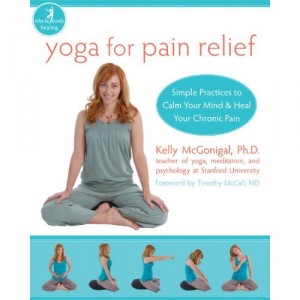To celebrate the release of her new book, Yoga for Pain Relief: Simple Practices to Calm Your Mind and Heal Your Chronic Pain, the author, Kelly McGonigal, PhD, is sharing a guest article today about gratitude for your body – even if your body’s in pain!
Body Gratitude
When was the last time you felt gratitude for your body?
When your body seems unpredictable or unreliable, it’s natural to feel abandoned or betrayed by your body. You may even start to feel separate from your body – like the true you is trying to enjoy life, but your body keeps getting in the way. Maybe it’s a specific part of your body that you start to dis-indentify with. There’s the true you, and then there’s this back or this knee or this headache that insists on hijacking your experience of life. Many people with chronic pain start to view their body as a prison and fantasize about escaping it.
For all these reasons, the phrase body gratitude can seem puzzling, even laughable, to many people with chronic pain. Gratitude for what?
You can start with the simple fact that this body is your companion on this life’s journey. It deserves to be recognized and appreciated for how it has carried you to this moment and allowed you to experience everything leading up to this moment.
Accepting your body exactly as it is will make every step toward healing easier. It’ll also go a long way in making the present moment, even with pain, more comfortable. The desire to be free of pain and suffering doesn’t require rejecting your body. You can’t walk away from your relationship with your body, no matter how much you feel betrayed by it or want to reject it. As advanced as modern medicine is, it hasn’t yet figured out how to trade in a body you no longer want for a new one.
The following gratitude practice is an opportunity to reflect on how your body has supported you. Your body isn’t separate from your courage, your strength, or your journey through life. It’s your companion, your home, and the instrument through which your life is expressed. Whatever personal strengths and experiences you’re grateful for, you can use to heal your relationship with your body.
Body Gratitude Practice Instructions
Summary: Reflect on different parts of your body with gratitude and appreciation.
Practice:
- Anytime to repair your relationship with your body.
- When you’re feeling discouraged by pain or illness, or critical about your body, to consciously choose friendliness toward your body.
- After a medical appointment, to remind you that your body is more than its symptoms or diagnoses.
A full practice will take five to ten minutes, but you can practice the essence of this reflection anytime by simply reminding yourself of one reason you’re grateful to your body.
To begin this practice, bring yourself into any supported position, seated or lying down.
Take a moment to feel your whole body, including any sensations of discomfort or pain. Then let your attention rest on how it feels to breathe for a few moments.
Now, one by one, reflect on different parts of your body with gratitude and appreciation. Ask yourself, How has this part of my body supported me in life? How has it allowed me to engage in life? Start with an area of the body that feels comfortable in this moment and eventually work your way around the body to an area that typically experiences pain.
Some areas to consider are (but you’re not limited to): feet, legs, hips, belly, back , chest, heart, lungs, shoulders, arms, hands, throat, face, and the sense organs (mouth, nose, eyes, ears).
Your answers may be literal or symbolic. For example, the heart literally fuels the entire body, moving oxygen to every cell in the body. In this way, the heart supports every action you’ve ever taken. You might thank your heart for giving the opportunity to experience each moment of your life. Symbolically, the heart sings with joy, expands with love, and pounds with excitement. You might feel gratitude to the heart for allowing you to experience each of these emotions. Literally, your feet and legs help you stand and move through life. Symbolically, you might reflect on the times you’ve stood up for what you believed in or on how far you’ve come in life.
Trust whatever comes up, even if it seems silly or sentimental. If nothing comes to mind immediately, try focusing on today. What has this area of your body done today? Did it help you prepare and enjoy a meal? turn the pages of a book? smile and kiss your dog? Even if today has been so difficult that you’ve been unable to do much of anything, you’re alive. Can you focus on gratitude for your lungs, your heart, and every system of the body that’s supporting you right now? Can you feel gratitude for how hard your body is working to support you and give you the opportunity to experience this moment?
Sometimes this meditation brings up sadness along with gratitude, especially if you find yourself thinking about things that your body no longer can do with ease. You may also find yourself feeling critical of some part of your body. Let these emotions and thoughts come and go without grasping on to them or rejecting them. Even as they arise out of habit, you can choose to return to the gratitude reflection.
Finish this practice by bringing your awareness back to your breath. Place your hands somewhere on the body where you can feel the movement of your breath. Repeat to yourself, Thank you for this breath. Thank you for this moment.
Kelly is a yoga teacher and health psychologist at Stanford University and the Editor in Chief of the International Journal of Yoga Therapy. She is also a former chronic pain sufferer. Many thanks to Kelly for a wonderful exercise.

